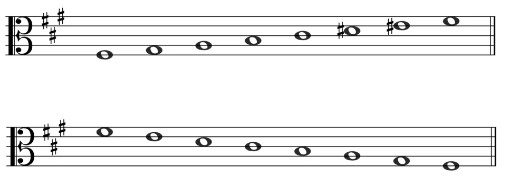In this lesson on music theory, we will be studying the F sharp melodic minor scale. The scale is diatonic and begins and ends on the note F#. The purpose of melodic minor scales is to aid in the creation of melodies. The ascending form of the melodic minor scale is identical to that of a major scale, except for a flat third, while the descending form is similar to a natural minor scale.
Contents
NOTES ON THE F# MELODIC MINOR SCALE
The F# melodic Minor Scale notes ascending are: F#, G#, A, B, C#, D#, E#
The scale notes of the F# melodic minor descending are: F#, E, D, C#, B, A, G#
F# MELODIC MINOR INTERVALS
The melodic minor scale is similar to the natural minor scale, except for the sixth and seventh degrees, which are raised by a semitone on the way up. The descending form of the scale is identical to that of the natural minor scale. Consequently, the minor 2nd interval between the 5th and 6th notes changes to a major 2nd interval. Additionally, there is another major 2nd interval between the 6th and 7th notes.
A major 2nd interval is equivalent to a whole step or a tone. For instance, E-F# is a whole step, and F#-G# is also a whole step.
The diagram below illustrates one octave of the F sharp melodic minor scale with labeled intervals. It’s essential to keep in mind that these intervals are consistent across all ascending melodic minor scales.

The descending melodic minor scale has the same intervals as a natural minor scale, which are displayed below.

THE MELODIC MINOR SCALE FOMULAR
The melodic minor scale formula is based on the natural minor scale but rather than being the same notes both ascending and descending they are different.
- On the way up we have a sharpened 6th and 7th degree
- On the way down these are lowered so the scale becomes it’s natural formula.
HOW TO PLAY THE D# MELODIC MINOR SCALE
On piano
To play both the ascending version of the melodic minor scale, you can refer to the diagram below. The fingerings are labeled beneath the scale.

To play the F# melodic minor scale in desending, you can refer to the diagram provided below.

On guitar
The melodic minor scale can be played in various positions on the guitar.

THE KEY SIGNATURE OF THE F# MELODIC MINOR

The melodic minor scale is commonly used in compositions that are in a minor key. This implies that if we are performing the F Sharp melodic minor scale, our piece will be in the key of F (natural) minor. F sharp minor is the relative minor of the A major scale, and both scales have a key signature of three sharps.
F# MELODIC MINOR ON CLEFS
Below is the F# Melodic Minor Scale written in the treble clef, bass clef, alto clef and tenor clef including both ascending and descending.
Treble Clef

Bass Clef

Alto Clef

Tenor Clef

CHORDS IN F SHARP MELODIC MINOR SCALE
The notes of F melodic minor can be used to create chords. You can find out more about this in our article on F melodic minor chords. The chords listed below are the chords present in the F melodic minor scale.

THE JAZZ F SHARP MELODIC MINOR SCALE
The jazz melodic minor scale is distinct from the standard melodic minor scale. As we have observed in classical music, the ascending melodic minor scale varies from the descending melodic minor scale. However, in jazz, both versions are identical, and both the 6th and 7th degrees are raised. Essentially, the jazz melodic minor scale corresponds to the ascending version of the classical music melodic minor scale.

If you’re interested in learning more about music scales, chords, and musical theory, visit our Guitar tunio today
